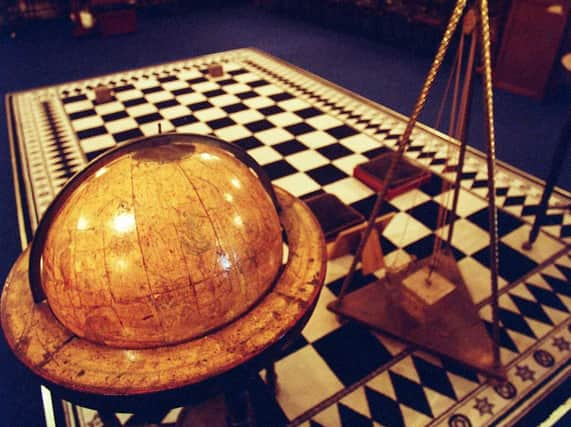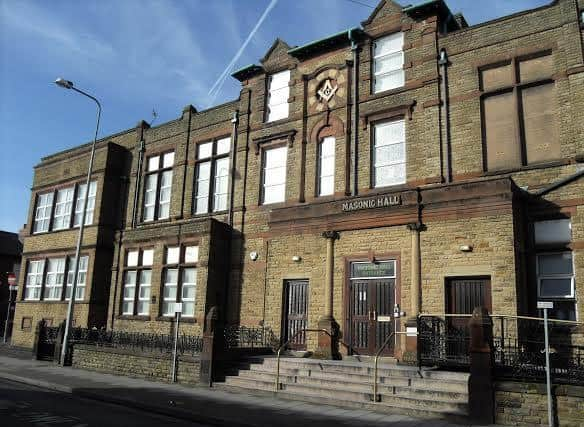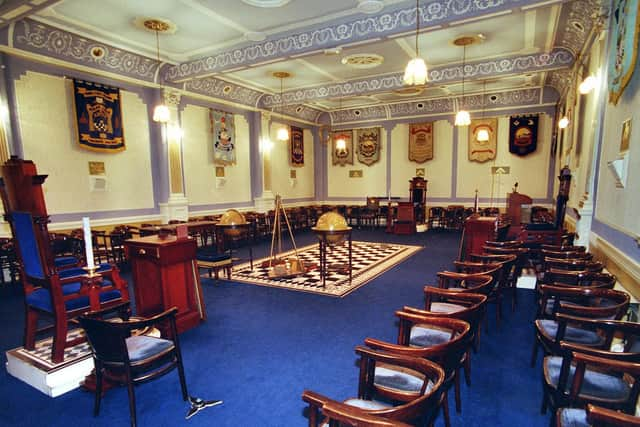Firm foundation for Fylde's Freemasons


A small piece of land at the top of Adelaide Street, at the junction with lower King Street was purchased by the Blackpool Masonic Hall limited on the 1st February 1888. And the land and subsquent buildings have remained for more than a century as the headquarters for the Blackpool branch of the West Lancashire Freemasons.
The cost of this plot was £1700. Blackpool Masonic Hall Limited had been incorporated on December 2 the previous year and six thousand £1 shares were issued.
Advertisement
Hide AdAdvertisement
Hide AdWhitaker Bond, the landlord of the Stanley Arms and Thomas Sankey, the school master of St Johns School owned the land.


From the signature of the original documents, it appears that the same Thomas Sankey was also the secretary of the Masonic Hall Limited.
Plans for building the hall were passed in 1896 and the right honourable Lord Skelmersdale laid the corner stone on May 7 1898.
He officially opened the building on Saturday September 23 1899. A mortgage of £2500 was arranged but they didn’t use all the available land - a small plot was left at the corner of Adelaide Street and King Street and also and area between the new masonic hall and the houses in Adelaide Street.
Advertisement
Hide AdAdvertisement
Hide AdThis was later sold to a Mr Esclome of Morecambe for £300 in 1900 and in 1919 was bought back complete with a house for £1075.


It went through a few sales but eventually was retained by the masons. It has had many alterations but has remained a part of the hall ever since.
During the alterations to the building it is believed that the corner stone was moved to its present position on the lounge wall.
However there is no minute book available that covers this event, a record of it actually happening or whether anything was found under the stone.
Advertisement
Hide AdAdvertisement
Hide AdThere are rumours, however, that guinea coins were found during some alterations to this particular part of the building.
During the period from the end of the First World War to the early thirties there was a great increase in the number of lodges consecrated, 16 in total, and the Hall was home to the majority of them. It was due to some extent to the extra income received from these new lodges that the mortgage was repaid in 1931. There is no indication in any of the deeds as to when the air raid shelter, which is under the main entrance steps, was built.
At the end of the Second World War, as with the first, there was a sudden increase in the number of lodges and accommodation had to be found for them. The Masonic Hall at Blackpool was a natural choice for those lodges whose mother lodge was already meeting at Adelaide Street.
The outcome of these new lodges, meeting at the masonic hall, was overcrowding and it was felt that more use could be made of the land at the corner of King Street and Adelaide Street. Plans were drawn up for an extension to the hall comprising a new lodge in the the basement and two storage rooms. On the first and second floors, new dinning rooms and toilets, an entrance door was constructed to King Street and a staircase leading to all three floors. Work for this started in 1955 and opened in June 1956. The brethren must have been very pleased with the new dinning rooms, previously they had to clear the lodge room after lodge had closed and then bring in the tables and chairs in order for the brethren to dine. The extension was financed by a generous offer of a £25,000 interest free loan by a member of the club and by 1974, all mortgages had been paid.
Advertisement
Hide AdAdvertisement
Hide AdHowever, by the early 1970s the club was facing financial problems. A meeting was convened to discuss the various problems and how best to deal with them.
Needless to say there was quite a number of heated discussions especially on the subject of raising the rents of the lodges, opening the hall for functions other than masonic meetings, which would of course, lead to ‘women’ being admitted to the hall. It might seem rather silly today that allowing women to enter the building could cause so much dissention.
At a group meeting in 1952 the question was asked regarding candidates or joining members whose wives were members of the ‘lady masons’. The answer, however, was that they could possibly be blackballed. The result of this meeting, at which the members voted for the rents to be raised and the hall opened to non-masons, affected the running of the club from that day up to the present time. Over the next couple of decades, entertainment was a big part of the hall. A dance floor was was installed, Saturday night bingo, lodge socials and family functions all added to the success of the hall. It was only the inflation in the 1980s which saw the entertainment side slip. Thesedays the Fylde suite is still a popular venue, particularly in the summer months.
The building was 100 years old in 1999 and apart from the alterations to the front entrance and the upvc windows which replaced the wooden ones the outside of the premises would be easily recognised by any of the masons who first met there. During its lifetime the masonic hall has passed through many phases, some good, some not so good. There have been many instances when decisions had to be made quickly, work needed to be done immediately and finances had to be found when the purse was nearly empty. Yet in every decade there has been a plethora of masons generous with their time energy and finances that have stepped forward to fill the breach. Quietly, efficiently and with enthusiasm they dealt with the problems so that the masonic hall remained sound attractive and comfortable for all that use it.
*Additional information and history have been provided by the curator of the Museum of Freemasonry Blackpool Brother Martyn Jones.